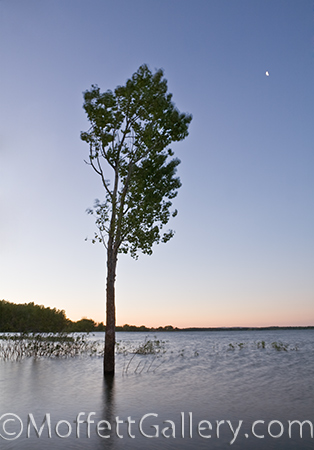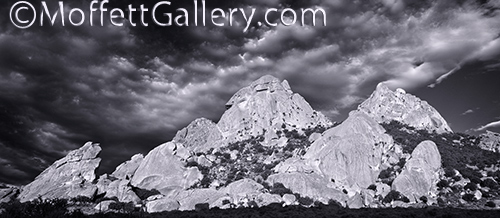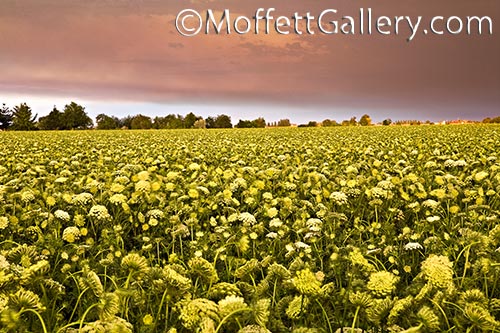by tmoffett | Jul 8, 2010 | Landscape, Photographic Philosophy, Uncategorized

Solitude
I love shooting photographs of the local areas. I feel that I get to know them, yet never tire of them. It seems that I see something different every time I return to a familiar place, or maybe I just see the same things differently. The light is always changing, so the same things can look totally different from day to day. I challenge you to go back to a favorite location many times over the course of a year and see how many different images you can create.
Lake Lowell is my “fallback” location. If I am wondering where to go, I go to the lake. I originally planned to do a 15 print portfolio from the lake, however by the time I had 15, I felt like I was just starting, so I kept going back. This is an image just shot this week. I was at one of my favorite evening locations, but this time in the morning. There was a completely different look in the morning than at sunset. Just prior to sunrise there was a coolness to the light. Everything was blue except for the western horizon which had a touch of red. Not a cloud in the sky and the breeze was blowing creating some motion in the trees and the grasses. It was cool for this time of year, and the bluish color enhanced the coolness in the air. The lone tree, surrounded by water in the cool, crisp morning air creates a cold, lonely feeling, but reaching out, not far away is the warmth of the rising sun.
To me, photography is all about feelings. If an image causes you to feel something it is a success.
by tmoffett | Jul 6, 2010 | Color, Composition, Landscape, Photo tips

Approaching Storm
I have always taught my students that photographing on the edge of the light is always best. Then the other day, John Paul Caponigro made a comment on Facebook relating to photographing on the edge of situations. It made me think, “Am I missing something here?” I believe I was.
Look at the approaching thunderstorm in this image. Where I am? On the edge. I have been able to capture the beauty of the storm, partially due to the fact that I am also using interesting light. What happens as you get caught in the middle of the storm. I did a few nights ago, and I tell you it wasn’t as pretty as this! The light goes away, it is dark. There is no direction to the little bit of light that there is, so it is flat and dark. Double whammy. Oftentimes wet and miserable as well.
As I look back at past images as well as events that I have covered, I have found that the best images usually do come from the edges. Don’t neglect completely the center, but do make sure to at least explore the edges, you just might find your next masterpiece there.
by tmoffett | Jul 5, 2010 | Color, Landscape, Photo tips

First Light
When in the morning do you begin photographing? Many photographers wait until the sun rises. I, on the other hand, will begin much earlier. I have found that many of my best images have been made long before the sun rises or long after it has set in the evening. I find the light to be quite fascinating prior to sunrise and after sunset.
This image, “First Light,” is just one such example. I was out with several photographers one morning and everyone, except me, was looking around and setting up cameras for their first shot, as the sun rose over the horizon and skimmed across the landscape. Yes, that would be impressive, but instead of mapping out what would later become a good image, I was searching for what was a great image right now! The western sky was wonderful! The light was already hitting the clouds coming over the mountains just a little, just enough to be able to capture them. This is my favorite image from a wonderful morning of photographing. The long shutter speed created some motion in the clouds to create some mystery, enhanced by the dark mountains below them.
I always teach to use a tripod, even when you think that you don’t need one. It forces you to slow down and think while you compose and shoot. In early morning and late evenings, it is a necessity. Also, using a cable release and the mirror lockup function on your camera helps to ensure that the camera is completely stable during the exposure. Using these techniques, the mountains are rendered completely sharp while the motion in the clouds creates the mood and feeling. Exposure in these situations is also extremely critical. A little over and the subtle highlights in the clouds will be ruined, a little under and the detail in the mountains is lost. Just right and you have a masterpiece!
Slow down, think, compose, expose. Take these steps and watch your images improve.
by tmoffett | Jul 2, 2010 | Color, Landscape, Photographic Philosophy

Fire In The Sky
Sunsets seem to capture everybody’s attention, and this one did for me. I will usually make sure that there is an interesting foreground, or even a silhouetted subject, but sometimes the clouds themselves can be the subject. Alfred Stieglitz did it in his series that he called Equivalents, so it must be alright! This is definitely no Stieglitz, but it does have its own merit. The color in the sky was incredible, and that alone became the subject here.
On the subject of Stieglitz, I too have a series of cloud images. I love Stieglitz’s work. Other photographers who I like and who have influenced me in my photographic journey are:
1. Paul Caponigro. He is my all time favorite. His images have feeling. I could look at them all day, every day and not tire of them.
2. John Sexton. Another master of black and white. He really knows and understands light. You can learn a lot from just studying his images.
3. Edward Weston. His series of peppers shows that you can find beauty in the ordinary.
4. Ruth Bernhard. I met her while in school. Interesting philosophy of photography. She taught me to stay at home and photograph there. You don’t have to go to exotic places to create meaningful images.
5. John Paul Caponigro. Very different style than his father, but very good. His thoughtful, philosophical approach to image making is incredible. He once reviewed my portfolio and I learned more in that half hour about meaningful photographs than I had in the previous year.
6. Joel Meyerowitz. His use of color is unrivaled. His conscious use of light and color are inspiring.
7. Yousuf Karsh. My favorite portrait photographer ever. His simple style and elaborate use of light made portraits that were simple in style yet very complex in meaning. He taught me how important it is to get to know your subject before photographing them.
8. Ansel Adams. Ansel has to be on the list. The zone system came from him. Zone system taught me about light and how to find quality light in nature.
9. Craig Law. Master Carbon Printer, and his silver prints were nothing to be ashamed of either. I endured many a critique under his tutelage at Utah State University. In my four years at USU he became a great friend as well as mentor.
10. R.T. Clark. Another Professor at Utah State. He taught me the importance of near perfection. I did more “reshoots” for him than any other instructor. I don’t regret it. I learned more by breaking down an image and rephotographing than I ever could have learned in a critique.
by tmoffett | Jul 1, 2010 | Black and White, Landscape

Twin Sisters, City of Rocks National Monument
It was a beautiful morning in City of Rocks National Monument last Saturday. We left Burley at about 4:30 AM in order to get there by sunrise. We stopped once to photograph the lunar eclipse. Had some interesting clouds that were illuminated by the moonlight. It is wonderful to get away from the city and enjoy nature for a while. It is even better to be able to photograph it!
We had been photographing around Twin Sisters prior to sunrise and made some good color images. However, we were just about to move on and check out other areas when the sunlight completely engulfed the rock and these wonderful clouds positioned themselves perfectly behind the rock. We stopped and photographed some more. The light was great for black and white, so that’s what I did.
I felt like I just figured out how to shoot here and the light quality weakened. This is a place I could definitely come back to. It always seems to take a couple of times in one area to really get a feel for what I want to do. The photographs get better with each visit. That is why I am a big advocate of photographing in your local area. You are familiar with it, therefore able to do a much better job with it.
by tmoffett | Jun 30, 2010 | Color, Composition, Landscape

Approaching Storm
I love a summer storm. The air is clean and it leaves a very fresh smell. Last night was no different.
I watched the thunderstorm slowly approaching and I decided to cut my cycling workout short so that I would have a chance to shoot in the evening light that generally is very dramatic when a storm passes through. I headed out at about 8:15, giving me just over an hour until sunset. My location was only about 20 minutes away. I never made it. The storm I was watching was in the west. I could see that the sun would shortly drop below the clouds and its light would skim across the surface of the fields where I was heading. However as I drove south I saw another dark cloud quickly approaching, packing lots of lightning. I soon realized that I would never reach my pre-determined location, so as the sun lowered below the clouds I stopped. The only place to pull over was directly under the power lines, a great place to be in a lightning storm! I grabbed my camera, placed it on my tripod (metal, of course), and started shooting. The sunlight lasted about 30 seconds, then the rain descended, by bucketfuls! The lightning was crashing all around me so I thought it best to retreat, which I did.
Just at the moment that the sun peeked under the clouds, it illuminated not only the onion field, which was blowing in the 30 MPH wind, but also sent a warm light onto the dark clouds in the east, causing them to appear red, which complements the green of the onions very nicely. Upon looking at the full sized image, I could see many of the onion tops crisp and sharp, while others were blowing, creating a very nice motion blur due to the half second exposure. It creates a very nice feel that is not as apparent in this web size image.
After retreating to my truck, I spent the next half hour trying to outrun the storm and find dry ground from which to shoot, but I had no luck. I finally retreated to the comfort of my home with the six exposures I was able to make before the storm hit.








Recent Comments